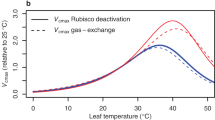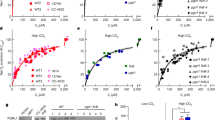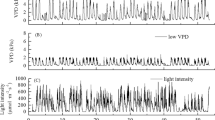Abstract
THREE different photosynthetic options have been identified in plants1,2: (1) most plants have the reductive pentose phosphate or C3 pathway, where CO2 is incorporated into ribulose-1,5-diphosphate (RuDP) to yield two molecules of 3-phosphoglyceric acid, a three-carbon compound; (2) the C4 mode, where the first photosynthetic products are four-carbon dicarboxylic acids like oxaloacetate and malate formed following CO2 incorporation into phosphoenolpyruvate (PEP); and (3) crassulacean acid metabolism (CAM), found in many succulent plants growing in arid regions. In the last, stomatal opening and net CO2 uptake occur at night, CO2 being incorporated by way of PEP carboxylase into organic acids. The tissue acidity decreases as the organic acids are decarboxylated during the day, when the internally released CO2 is prevented from leaving by the closed stomata. The water vapour concentration difference between the tissue and ambient air is less at night, and thus the night-time stomatal opening of CAM plants leads to overall water conservation. For example, the water lost per CO2 fixed averages about sixfold higher for C4 plants and tenfold higher for C3 ones than for CAM plants in natural conditions2. The net daily CO2 uptake by CAM plants is less than for C3 or C4 plants, so CAM plants tend to be relatively slow growing.
This is a preview of subscription content, access via your institution
Access options
Subscribe to this journal
Receive 51 print issues and online access
$199.00 per year
only $3.90 per issue
Buy this article
- Purchase on Springer Link
- Instant access to full article PDF
Prices may be subject to local taxes which are calculated during checkout
Similar content being viewed by others
References
Black, C. C., A. Rev. Pl. Physiol., 24, 253–286 (1973).
Szarek, S. R., and Ting, I. P., in Environmental and Biological Control of Photosynthesis (edit. by Marcelle, R.), 289–297 (W. Junk, The Hague, 1975).
Munz, P. A., A Flora of Southern California, 864 (University of California Press, Berkeley, 1974).
Koller, D., U.S. Atomic Energy Commission Report TID-4500 (UCLA 12-797), 1–28 (1970).
Mork, H. M., Farmer, R. W., and Flygare, K. A., Soil Sci., 114, 61–68 (1972).
Neales, T. F., Aust. J. biol. Sci., 26, 705–714 (1973).
Szarek, S. R., and Ting, I. P., Pl. Physiol, Baltimore, 54, 76–81 (1974).
Wallace, A., Hale, V. Q., Kleinkopf, G. E., and Huffaker, R. C., Ecology, 52 1093–1095 (1971).
Downton, W. J. S., and Tregunna, E. B., Can. J. Bot., 46, 207–215 (1968).
Kluge, M., and Fisher, K., Planta, 77, 212–223 (1967).
Neales, T. F., Patterson, A. A., and Hartney, V. J., Nature, 219, 469–472 (1968).
Bartholomew, B., Photosynthetica, 7, 114–120 (1973).
Osmond, C. B., et al., Nature, 246, 41–42 (1973).
Author information
Authors and Affiliations
Rights and permissions
About this article
Cite this article
HARTSOCK, T., NOBEL, P. Watering converts a CAM plant to daytime CO2 uptake. Nature 262, 574–576 (1976). https://doi.org/10.1038/262574b0
Received:
Accepted:
Issue Date:
DOI: https://doi.org/10.1038/262574b0
This article is cited by
-
Physiological differences and changes in global DNA methylation levels in Agave angustifolia Haw. albino variant somaclones during the micropropagation process
Plant Cell Reports (2016)
-
Identification of obligate C3 photosynthesis in Dendrobium
Photosynthetica (2015)
-
De novo transcriptome assembly of drought tolerant CAM plants, Agave deserti and Agave tequilana
BMC Genomics (2013)
-
Seasonal photosynthetic gas exchange and water-use efficiency in a constitutive CAM plant, the giant saguaro cactus (Carnegiea gigantea)
Oecologia (2011)
-
Photosynthesis in Pineapple (Ananas comosus comosus [L.] Merr) Measured Using PAM (Pulse Amplitude Modulation) Fluorometry
Tropical Plant Biology (2010)
Comments
By submitting a comment you agree to abide by our Terms and Community Guidelines. If you find something abusive or that does not comply with our terms or guidelines please flag it as inappropriate.



